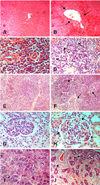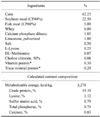1. Bergsjø B, Langseth W, Nafstad I, Jansen JH, Larsen HJ. The effects of naturally deoxynivalenol-contaminated oats on the clinical condition, blood parameters, performance and carcass composition of growing pigs. Vet Res Commun. 1993. 17:283–294.

2. Budesministerium für Ernahrung, Landwirtschaft und Forsten (BML). Orientierungswerte fur die beurteilung der gehalte an deoxynivalenol und zearalenon in futtermitteln im rahmen des § 3 des futtermittelgesetzes. 2000. Berlin: BML;1–2.
3. Chang K, Kurtz HJ, Mirocha CJ. Effects of the mycotoxin zearalenone on swine reproduction. Am J Vet Res. 1979. 40:1260–1267.
4. Cheng YH, Shen TF, Pang VF, Chen BJ. Effects of aflatoxin and carotenoids on growth performance and immune response in mule ducklings. Comp Biochem Physiol C Toxicol Pharmacol. 2001. 128:19–26.

5. Döll S, Dänicke S, Ueberschär KH, Valenta H, Schnurrbusch U, Ganter M, Klobasa F, Flachowsky G. Effects of graded levels of fusarium toxin contaminated maize in diets for female weaned piglets. Arch Tierernahr. 2003. 57:311–334.

6. Green ML, Stouffer DK, Scheidt AB, Long GG, Diekman MA. Evaluation of use of progesterone to counteract zearalenone toxicosis during early pregnancy in gilts. Am J Vet Res. 1991. 52:1871–1874.
7. Harvey JW, Bruss M, Kaneko JJ. Clinical biochemistry of domestic animals. 1997. 5th ed. San Diego: Academic Press.
8. Ihara T, Sugamata M, Sekijima M, Okumura H, Yoshino N, Ueno Y. Apoptotic cellular damage in mice after t-2 toxin-induced acute toxicosis. Nat Toxins. 1997. 5:141–145.

9. James LJ, Smith TK. Effect of dietary alfalfa on zearalenone toxicity and metabolism in rats and swine. J Anim Sci. 1982. 55:110–118.

10. Kinser S, Jia Q, Li M, Laughter A, Cornwell P, Corton JC, Pestka J. Gene expression profiling in spleens of deoxynivalenol-exposed mice: Immediate early genes as primary targets. J Toxicol Environ Health A. 2004. 67:1423–1441.

11. Kubena LF, Huff WE, Harvey RB, Corrier DE, Phillips TD, Creger CR. Influence of ochratoxin and deoxynivalenol on growing broiler chicks. Poult Sci. 1988. 67:253–260.
12. Overnes G, Matre T, Sivertsen T, Larsen HJ, Langseth W, Reitan LJ, Jansen JH. Effects of diets with graded levels of naturally deoxynivalenol-contaminated oats on immune response in growing pigs. Zentralbl Veterinarmed A. 1997. 44:539–550.

13. Rotter BA, Prelusky DB, Pestka JJ. Toxicology of deoxynivalenol (vomitoxin). J Toxicol Environ Health. 1996. 48:1–34.
14. Rotter BA, Thompson BK, Clarkin S, Owen TC. Rapid colorimetric bioassay for screening of fusarium mycotoxins. Nat Toxins. 1993. 1:303–307.

15. Rotter BA, Thompson BK, Lessard M, Trenholm HL, Tryphonas H. Influence of low-level exposure to fusarium mycotoxins on selected immunological and hematological parameters in young swine. Fundam Appl Toxicol. 1994. 23:117–124.

16. Shifrin VI, Anderson P. Trichothecene mycotoxins trigger a ribotoxic stress response that activates c-jun n-terminal kinase and p38 mitogen-activated protein kinase and induces apoptosis. J Biol Chem. 1999. 274:13985–13992.

17. Tiemann U, Brüssow KP, Küchenmeister U, Jonas L, Kohlschein P, Pöhland R, Dänicke S. Influence of diets with cereal grains contaminated by graded levels of two fusarium toxins on selected enzymatic and histological parameters of liver in gilts. Food Chem Toxicol. 2006. 44:1228–1235.

18. Ueno Y. Ueno Y, editor. General toxicology. Trichothecene - Chemical, Biological and Toxicological Aspects. 1983. Amsterdam: Elsevier;135–146.
19. Zhou HR, Yan D, Pestka JJ. Differential cytokine mrna expression in mice after oral exposure to the trichothecene vomitoxin (deoxynivalenol): Dose response and time course. Toxicol Appl Pharmacol. 1997. 144:294–305.

20. Zhou HR, Yan D, Pestka JJ. Induction of cytokine gene expression in mice after repeated and subchronic oral exposure to vomitoxin (deoxynivalenol): Differential toxin-induced hyporesponsiveness and recovery. Toxicol Appl Pharmacol. 1998. 151:347–358.









 PDF
PDF ePub
ePub Citation
Citation Print
Print




 XML Download
XML Download